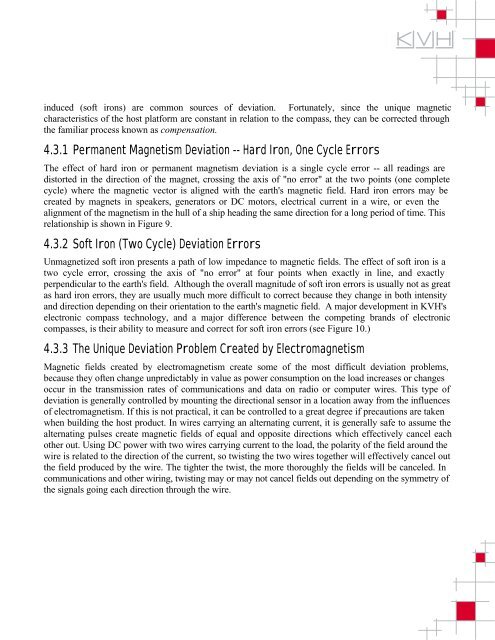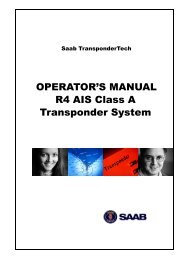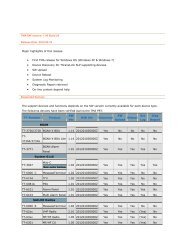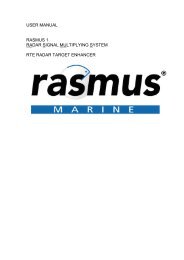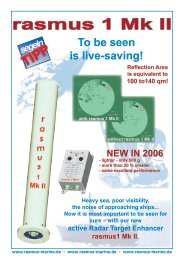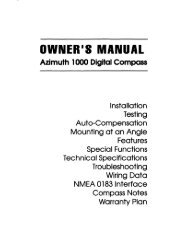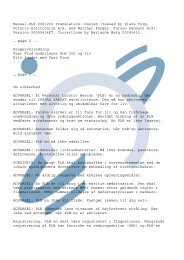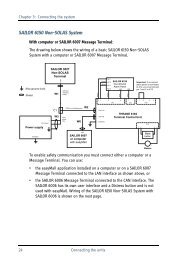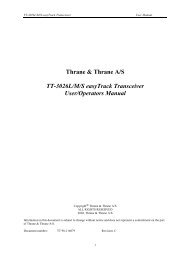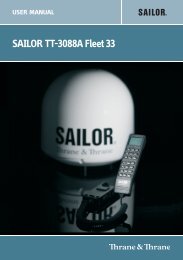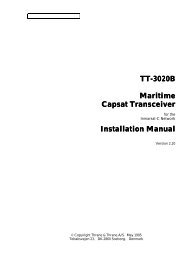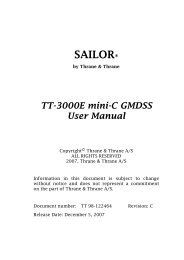Overview of Compass Technology - KVH Industries, Inc
Overview of Compass Technology - KVH Industries, Inc
Overview of Compass Technology - KVH Industries, Inc
You also want an ePaper? Increase the reach of your titles
YUMPU automatically turns print PDFs into web optimized ePapers that Google loves.
induced (s<strong>of</strong>t irons) are common sources <strong>of</strong> deviation. Fortunately, since the unique magnetic<br />
characteristics <strong>of</strong> the host platform are constant in relation to the compass, they can be corrected through<br />
the familiar process known as compensation.<br />
4.3.1 Permanent Magnetism Deviation -- Hard Iron, One Cycle Errors<br />
The effect <strong>of</strong> hard iron or permanent magnetism deviation is a single cycle error -- all readings are<br />
distorted in the direction <strong>of</strong> the magnet, crossing the axis <strong>of</strong> "no error" at the two points (one complete<br />
cycle) where the magnetic vector is aligned with the earth's magnetic field. Hard iron errors may be<br />
created by magnets in speakers, generators or DC motors, electrical current in a wire, or even the<br />
alignment <strong>of</strong> the magnetism in the hull <strong>of</strong> a ship heading the same direction for a long period <strong>of</strong> time. This<br />
relationship is shown in Figure 9.<br />
4.3.2 S<strong>of</strong>t Iron (Two Cycle) Deviation Errors<br />
Unmagnetized s<strong>of</strong>t iron presents a path <strong>of</strong> low impedance to magnetic fields. The effect <strong>of</strong> s<strong>of</strong>t iron is a<br />
two cycle error, crossing the axis <strong>of</strong> "no error" at four points when exactly in line, and exactly<br />
perpendicular to the earth's field. Although the overall magnitude <strong>of</strong> s<strong>of</strong>t iron errors is usually not as great<br />
as hard iron errors, they are usually much more difficult to correct because they change in both intensity<br />
and direction depending on their orientation to the earth's magnetic field. A major development in <strong>KVH</strong>'s<br />
electronic compass technology, and a major difference between the competing brands <strong>of</strong> electronic<br />
compasses, is their ability to measure and correct for s<strong>of</strong>t iron errors (see Figure 10.)<br />
4.3.3 The Unique Deviation Problem Created by Electromagnetism<br />
Magnetic fields created by electromagnetism create some <strong>of</strong> the most difficult deviation problems,<br />
because they <strong>of</strong>ten change unpredictably in value as power consumption on the load increases or changes<br />
occur in the transmission rates <strong>of</strong> communications and data on radio or computer wires. This type <strong>of</strong><br />
deviation is generally controlled by mounting the directional sensor in a location away from the influences<br />
<strong>of</strong> electromagnetism. If this is not practical, it can be controlled to a great degree if precautions are taken<br />
when building the host product. In wires carrying an alternating current, it is generally safe to assume the<br />
alternating pulses create magnetic fields <strong>of</strong> equal and opposite directions which effectively cancel each<br />
other out. Using DC power with two wires carrying current to the load, the polarity <strong>of</strong> the field around the<br />
wire is related to the direction <strong>of</strong> the current, so twisting the two wires together will effectively cancel out<br />
the field produced by the wire. The tighter the twist, the more thoroughly the fields will be canceled. In<br />
communications and other wiring, twisting may or may not cancel fields out depending on the symmetry <strong>of</strong><br />
the signals going each direction through the wire.


